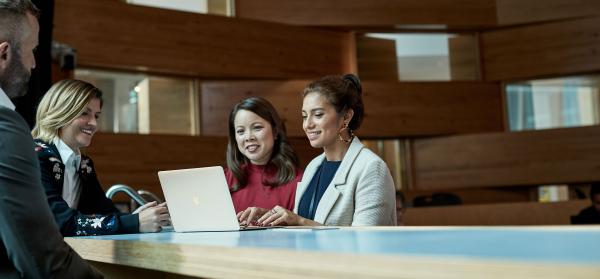Here’s something you may not know: increasing the number of women in science makes research better, and it also makes research teams smarter.

That’s right — studies show that scientific research is more accurate when gender is considered, that gender diversity is important for the outcome of scientific teams, and that having a higher proportion of women on a team increase its collective intelligence.[3][2][1]
These are pretty compelling reasons to roll out the red carpet for women who are considering a career in science. Whichever way you slice it, increasing female participation in this vital field of enquiry is good for everyone.
Somehow, though, women are still a minority in science, technology, engineering and mathematics (STEM). According to the State of STEM Gender Equity, an annual monitor released by the Department of Industry, Science and Resources, women make up only 36% of enrolments in university STEM courses and 27% of the workforce across all STEM industries in Australia.
So, what’s stopping girls and women from finding their place in science? And what can we do about it?

There’s a shortage of female leaders in science
First, some good news. In Australia, the proportion of women in STEM-qualified positions is growing, albeit incrementally. Between 2020 and 2021, it increased to 15 per cent, up from 13 per cent the year before.
What’s more, the gender pay gap is shrinking, and we’re also seeing women outnumber men in various scientific disciplines, including life sciences (58 per cent women) and medical laboratory science (61 per cent women).
But while we might be seeing more women in science, what we’re not seeing are more female leaders in science. Only 23 per cent of senior managers and 8 per cent of CEOs in STEM-qualified industries are women.
You might be inclined to say, ‘So what?’ First, we need to get the women into STEM and science in the first place. Then we can worry about getting them into the top jobs, right?
Nope.
Because a big part of getting more girls and women into science is giving them something to aspire to. That means showing them success stories of other girls and women who’ve blazed the trail ahead of them and have achieved inspiring outcomes.
You can’t be what you can’t see
Research into the impact of female STEM role models on girls aged 12-16 years showed that role model intervention (that is, giving girls the opportunity to hear from female STEM professionals) positively impacts girls’ aspirations in STEM and their expectations of success on STEM choices.[4]
Another study revealed that the number of girls in Europe with an interest in STEM almost doubles, on average, when they have a role model to inspire them.[5]
That’s because role models ‘embody representations of the possible’ — seeing empowering examples of women in science will show other girls and women that there’s a place for them in this global field. [6]
There are already countless examples of female scientists whose breakthrough discoveries are shaping the global science field. Here in Australia, women are developing a rapid test to diagnose early-stage pre-eclampsia, conserving and rehabilitating aquatic ecosystems by optimising coral nutrition, and using ‘odour profiling’ to transform what we know about forensic evidence, among other remarkable achievements.
But we can’t stop here. These female science leaders are blazing a trail for future generations; now, we need to equip more women to follow in their footsteps.
Postgraduate study will drive the next generation of female science leaders
If we want women to take their place at the forefront of scientific leadership, we need to equip them with the skills and opportunities to rise through the ranks. Postgraduate study — essentially a curated path towards senior roles in science — is a straightforward pathway to advancement.
While an undergraduate degree is about the theory and practice of science, postgraduate science is about grappling with complexity, exploring opportunities for leadership, and pushing the boundaries of possibility.
And no pressure, but, according to Australia’s Chief Scientist Dr Cathy Foley, getting more female scientists into the workforce is about more than representation. Australia’s future — and the world — depends on it.
“Getting the settings right for women and for other groups in our community is about equity,” she said.
“It will also ensure we can fill the skills gaps in industries set to shape Australia over the next two decades, by making use of our full human potential.”
Find out more about UTS postgraduate science
3 reasons gender diversity is crucial to science. Elsevier Connect, 2018[1]
The impact of gender diversity on scientific research teams. nature.com, 2022. [2]
ibid.[3]
Girls in STEM: Is it a Female Role-Model Thing? Frontiers in Psychology, 2020.[4]
Girls in STEM: the importance of role models. Microsoft, 2018. [5]
Testing the motivational effects of attainable role models: Field and experimental evidence. Journal of Theoretical Social Psychology, 2021.[6]

